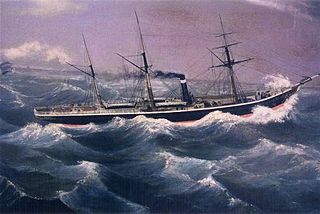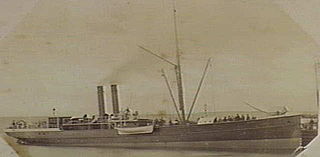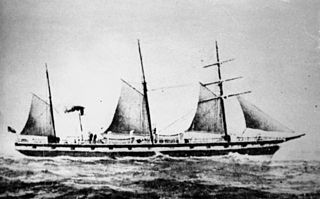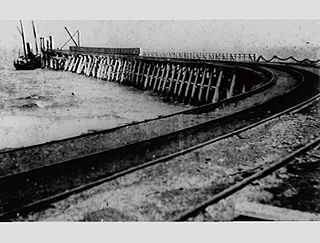
SS Yongala was a passenger steamship that was built in England in 1903 for the Adelaide Steamship Company. She sank in a cyclone off the coast of Queensland in 1911, with the loss of all 122 passengers and crew aboard.

SS Elingamite was an Australian passenger steamer of 2,585 tons, built in 1887, and owned by Huddart Parker. The ship was wrecked on 9 November 1902 off the north coast of New Zealand carrying a large consignment of gold. Now the Elingamite wreck is a favourite site for adventurous divers because of the drama associated with it, and wild tales of lost treasure.
SS Cambridge was a refrigerated steam cargo liner that was built in Germany for the Hamburg America Line. She was launched in 1916 as Vogtland, but after the 1919 Treaty of Versailles the United Kingdom took her as war reparations and sold her to the Federal Steam Navigation Company, who renamed her Cambridge. She operated between Britain and Australasia until 1940, when a German mine sank her off the coast of Australia.

SS Admella was an Australian passenger steamship that was shipwrecked on a submerged reef off the coast of Carpenter Rocks, south west of Mount Gambier South Australia, in the early hours of 6 August 1859. Survivors clung to the wreck for over a week and many people took days to die as they glimpsed the land from the sea and watched as one rescue attempt after another failed.

SS Alert was a steamship that sank off Cape Schanck, Victoria, Australia on 28 December 1893. The ship was built for the gentle waters of Scottish lochs and was almost 51 m (167 ft) long and weighed 247 tonnes.

SS City of Launceston was a 368 GRT steamship operated by the Launceston and Melbourne Steam Navigation Company from 1863, which had an early role in colonial steam shipping as the forerunner of the modern Bass Strait ferry service between Tasmania and Victoria. It was sunk in Port Phillip Bay after a collision with another ship on 19 November 1865.

SS Gothenburg was an iron-hulled sail- and steamship that was built in England in 1854 and sailed between England and Sweden until 1862. She then moved to Australia, where she operated across the Tasman Sea to and from New Zealand until 1873, when she was rebuilt. After her rebuild, she operated in the Australian coastal trade.

The Joseph H Scammell was a Canadian sailing ship that was built at Eatonville, Nova Scotia in 1884 and shipwrecked at Point Danger, Torquay, Victoria, Australia in 1891. Her wreck triggered a large scale episode of shipwreck pilfering and smuggling.

The SSCity of Boston was a British iron-hulled single-screw passenger steamship of the Inman Line which disappeared in the North Atlantic Ocean en route from Halifax, Nova Scotia, to Liverpool in January 1870.

SS London was a British steamship that sank in the Bay of Biscay on 11 January 1866. The ship was travelling from Gravesend, England to Melbourne, Australia, when she began taking in water on 10 January, with 239 persons aboard. The ship was overloaded with cargo, and thus unseaworthy, and only 19 survivors were able to escape the foundering ship by lifeboat, leaving a death toll of 220.

SS Ferret was an iron screw steamship of 460 tons built in Glasgow (Scotland) in 1871 by J & G Thomson, Glasgow.

SS Clan Ranald is a steamship wreck off the coast of South Australia that is of unique historic importance. She is the only example in Australian waters of a turret deck ship: a type of steel-hulled cargo ship with an unusual hull shape that was built in the 1890s and 1900s.

The Merksworth was an iron steamer screw built in 1874 at, Paisley, that was wrecked when it swamped whilst carrying coal between Newcastle and Sydney and was lost off Stockton Beach on 7 May 1898.
HMAS Coogee was a passenger ferry that briefly served as a Royal Australian Navy armed patrol vessel and minesweeper in the latter part of the First World War. She was launched in 1887 and scuttled in 1928.
Clonmel was a three-masted wooden paddle steamer built in Birkenhead, England, in 1836. Clonmel was one of the first steam-powered vessels on the Australian coast. It ran aground in the early hours of 2 January 1841, or the 3rd. and was wrecked on what is now known as Clonmel Island in Corner Inlet, Victoria. This was only its second voyage from Sydney.
SS Marloo is a shipwreck at Great Sandy National Park, Fraser Island, Fraser Coast Region, Queensland, Australia. It was added to the Queensland Heritage Register on 12 October 2002 but delisted in 2015.

SS Collaroy was an iron paddle steamer which often travelled between Newcastle and Sydney. The ship was named after a sheep station near Cassilis in the Hunter Valley, Australia. It was launched in 1853 in Birkenhead, England. The ship's name is now the location of the present day suburb of Collaroy.
Cheviot was a ship launched in Sunderland in 1827. Initially she sailed between London and Quebec. Then in 1831 she became a whaler and sailed to the British Southern Whale Fishery. She never returned to England from that voyage, instead becoming based in Hobart and remaining there as whaler and merchantman. She was lost in March 1854.
SS Petriana was an iron screw steamer built in 1879 that was converted into an oil tanker. On 28 November 1903, while transporting 1,300 tonnes of petroleum from Borneo to Australia, it struck a reef near Point Nepean, Victoria, outside of Port Phillip Bay. The vessel was subsequently abandoned, but not before its cargo was released as part of efforts to save the ship, causing Australia's first major oil spill. Under the White Australia policy, the Chinese and Malay sailors crewing the Petriana were refused entry to Australia and forced to stay on a crowded tugboat for several days. Their treatment led to a political controversy in the lead-up to the 1903 federal election.
The SS Commodore was a British-registered collier. She was built at Newcastle upon Tyne in 1870 and served with three companies. She was driven into shallow waters off Sheringham, Norfolk on 7 November 1896. Local fishermen tried to render assistance but were driven off by gale force winds. After the Commodore was driven onto rocks she sent a distress signal and the Sheringham lifeboat Henry Ramey Upcher took off all 14 crew and 3 stranded fishermen. The wreck was blown up in 1906 as a hazard to the Sheringham fishing fleet. The remains were exposed by storms in September 2021.












